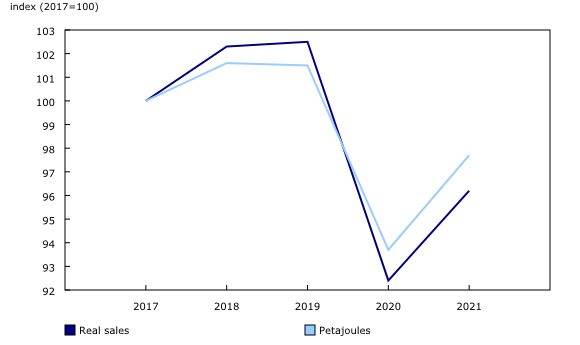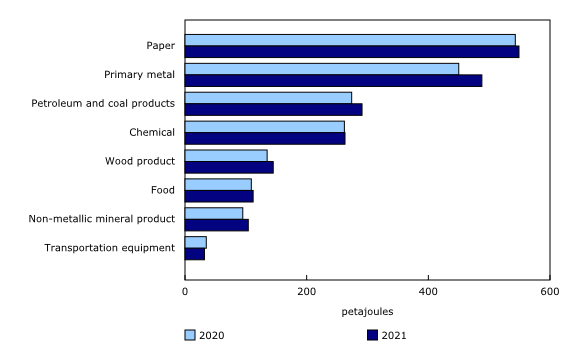Energy consumption by the manufacturing sector, 2021
Released: 2022-10-31
2 109 petajoules
2021
4.3% 
(annual change)
In 2021, energy consumed by the manufacturing sector increased by 4.3% from 2020 to 2 109 petajoules, reversing the downward trend experienced during the first year of the COVID-19 pandemic.
In 2020, public health measures put in place to reduce the spread of the COVID-19 virus and disruptions in global supply chains restricted economic activity. By mid-December 2020, vaccines became available and, in 2021, restrictions were relaxed. Global economies reopened, though there remained significant supply chain issues, such as shortages of microchips, plastic resins, petrochemicals and other raw materials. Manufacturing activity began to rebound during the second year of the pandemic, resulting in a higher demand for energy.
During 2021, the manufacturing sector consumed 2 109 petajoules of energy as part of the production process, up 4.3% from 2020. For context, one petajoule approximately equals the amount of energy required to operate the Montréal subway system for one full year. Real sales for the manufacturing sector increased 4.1%, and the annual average capacity utilization rate rose 3.6% during this period.
Although manufacturing activity began to recover in 2021, it remained below pre-pandemic levels. In 2021, real sales were 6.2% lower and energy consumption was 3.7% lower compared with 2019.
Paper and primary metal manufacturers continue to be the top energy consumers
In 2021, the top energy consumers were paper (548.9 petajoules) and primary metal manufacturers (487.8 petajoules), which together accounted for almost half (49.1%) of all energy consumed by the manufacturing sector. Petroleum and coal products (290.9 petajoules) and chemical manufacturing (263.4 petajoules) accounted for 26.3% of energy consumption.
The consumption of energy in the manufacturing industries does not necessarily reflect sales volumes. Despite making up close to half of all energy consumed, paper manufacturing and primary metal manufacturing accounted for just over one-tenth (11.3%) of the total real sales of goods manufactured (shipments) in 2021.
Transportation equipment only top consumer to reduce energy consumption in 2021
The largest increase in energy consumption occurred in primary metal, which consumed an additional 38.1 petajoules (+8.5%) in 2021. Rising demand for iron, steel and aluminum and lower production in China contributed towards an increase in production and energy consumption by the primary metal manufacturing industry. Energy consumption in petroleum and coal products manufacturing increased by 16.5 petajoules or 6.0%. Higher global demand for petroleum and higher exports of energy products contributed to increased energy consumption in 2021.
Paper manufacturing, the largest consumer of energy, consumed an additional 5.7 petajoules (+1.1%) in 2021 compared with 2020. Economic factors, such as decreasing demand for newsprint and increasing costs of operations, resulted in some mills closing indefinitely in 2020. Energy consumption in miscellaneous manufacturing increased by 0.3 petajoules (+6.1%) in 2021. This industry includes businesses that produce medical equipment and supplies, including personal protective equipment, such as clothing and masks, which were required during the pandemic to prevent the spread of COVID-19.
Energy consumption in the transportation equipment manufacturing industry declined 7.4% in 2021 following a drop of 18.0% in 2020. In 2021, real sales dropped by 8.4%, led by declines in motor vehicle and aerospace product and parts. Travel restrictions and supply issues, such as the global semiconductor chip shortage, continued to affect the transportation industry during the second year of the pandemic. Temporary shutdowns and ramping down of production occurred throughout the year at auto assembly plants and, as a result, many auto part manufacturers reduced their production.
Natural gas and electricity are the largest sources of energy consumption
Natural gas and electricity, the most common sources of energy, are used in all manufacturing industries.
In 2021, 659.3 petajoules of natural gas was consumed, accounting for almost one-third (31.3%) of the total energy used by the manufacturing sector. The largest consumers of natural gas were chemical manufacturing (156.5 petajoules) and primary metal manufacturing (116.6 petajoules), which, combined, accounted for 41.4% of the total natural gas consumed. Electricity accounted for 631.6 petajoules or 29.9% of total energy consumed by the manufacturing sector. The primary metal industry (256.2 petajoules) and the paper manufacturing industry (121.8 petajoules) were the largest electricity consumers, accounting for 59.9% of total electricity consumed.
Spent pulping liquor was consumed solely by the paper manufacturing industry and accounted for 10.7% (225.4 petajoules) of the total energy consumed. Coals and cokes (196 petajoules) accounted for 9.3% of the total energy consumed. Primary metal, petroleum and coal products and non-metallic mineral product manufacturing were the primary users of coals and cokes. Wood (185.7 petajoules) accounted for 8.8% and was primarily used by the wood product and paper manufacturing industries. Refinery fuel gas (133.6 petajoules), mainly consumed by the petroleum and coal products manufacturing industry, made up 6.3%, and all other energy sources combined accounted for the remaining 3.7% of total energy consumed.
Note to readers
The Annual Industrial Consumption of Energy Survey, sponsored by Natural Resources Canada and Environment and Climate Change Canada, estimates the energy consumed by type of fuel in Canadian manufacturing.
The 2021 survey estimates are based on a sample of 4,860 manufacturing establishments, which represent a weighted response rate of 82.29%.
A joule is a derived measure of energy or work. One gigajoule is equal to one billion (109) joules. The energy content of a 30-litre tank of gasoline is about one gigajoule, and six gigajoules are roughly equivalent to the amount of potential energy from burning one US standard barrel of oil. One petajoule is equal to 1015 joules, or one million gigajoules. One petajoule approximately equals the amount of energy required to operate the Montréal subway system for one full year.
Energy includes the energy used as fuel to power the production process, for heating, for transportation at the establishment, and for generating steam consumed on site.
Other energy sources include butane, heavy fuel oil, middle distillates, propane and purchased steam.
Electricity consists of both purchased and self-generated electricity.
Coals and cokes grouping includes coal, coal coke, coke oven gas, petroleum coke and coke from catalytic cracking.
Totals and percentages may not add up because of rounding.
Manufacturing sales are from Table 16-10-0013-01.
Manufacturing capacity utilization rates are derived from Table 16-10-0012-01.
Data for 2020 have been finalized. Data for 2021 are subject to revision.
Contact information
For more information, or to enquire about the concepts, methods or data quality of this release, contact us (toll-free 1-800-263-1136; 514-283-8300; infostats@statcan.gc.ca) or Media Relations (statcan.mediahotline-ligneinfomedias.statcan@statcan.gc.ca).
- Date modified:



